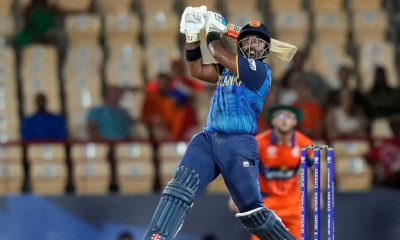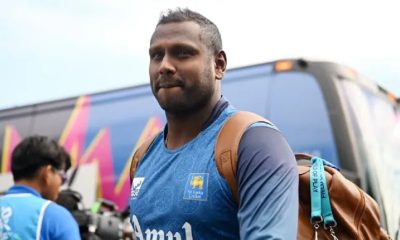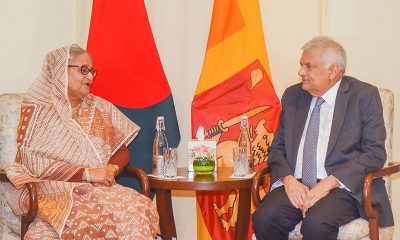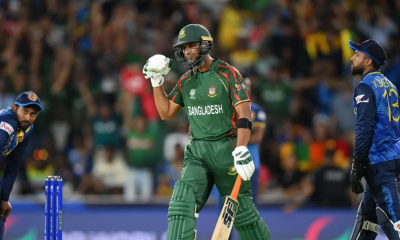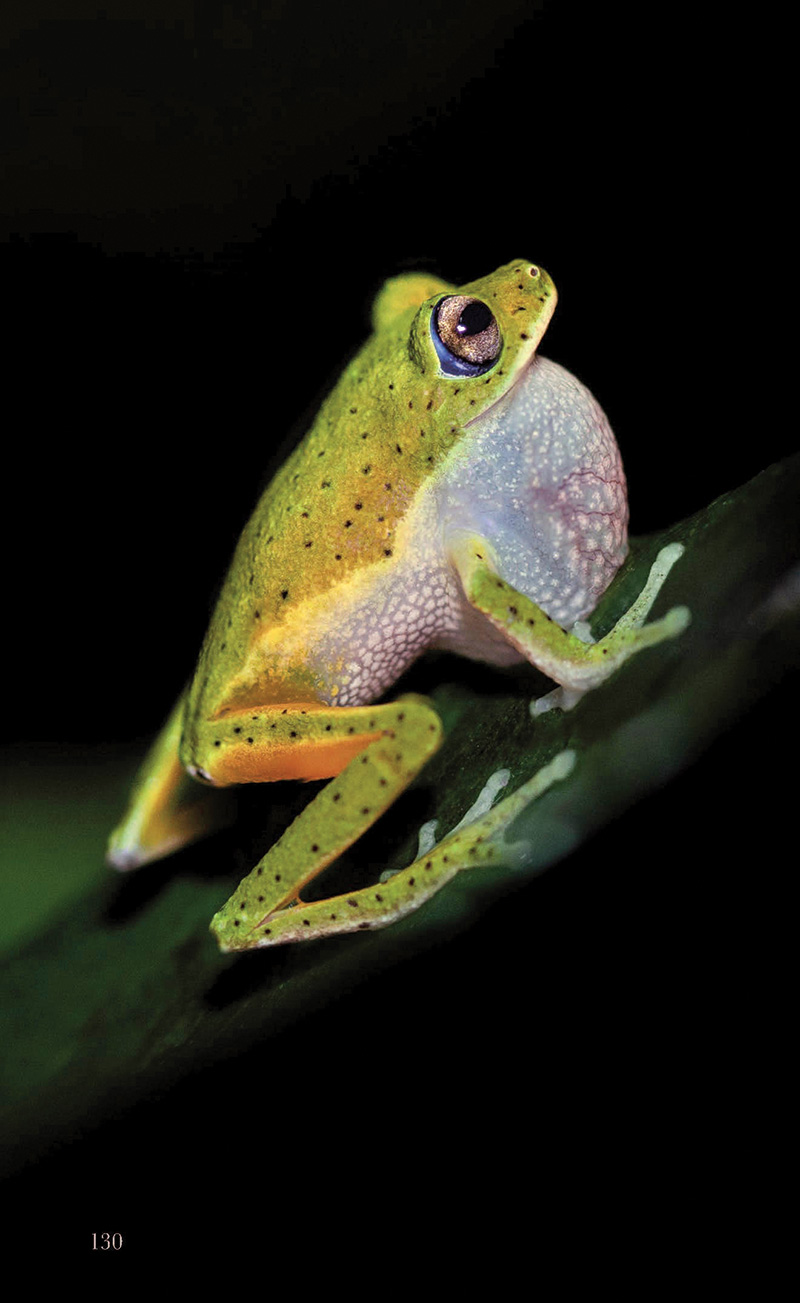Features
THOSE WERE THE DAYS

By AN OCTOGENARIAN
The Bridge on the River Kwai’ Though filmed in Sri Lanka was the award winning movie ‘The Bridge on the river Kwai,’ which was based on the building of a bridge 277 miles in length connecting Burma ( now known as Myanmar ) with Siam ( now known as Thailand ) during World War II by prisoners of war held by the Japanese. These POW were from Britain, Australia Holland , USA and around 200,000 conscripted civilians.
The highlight of the movie was the blowing up of the specially constructed bridge which spanned the Kelani Ganga in the picturesque and sleepy village of Kitulgala located at the foot of the Gingathena Pass. Directed by David Lean, it featured a star cast which included Sir Alec Guinness, William Holden, Jack Hawkins, Sessue Hayakawa and Anne Seans all of whom visited this island for the filming. Also included in this team was our own cameraman Willie Blake who was renowned for his filming of jungle life.
This movie will best be remembered for the “Colonel Bogey March,” which was whistled by the Allied prisoners of war as they marched on the orders of their Japanese captors. But mischievous schoolboys made the tune more spicy by introducing ribald and humorous lyrics about some of the war-time German Generals.
Emily and Vada Kaha Sudiya
June 20, 1955 will be always remembered as the day when there was a early morning total eclipse of the sun leaving Colombo in complete darkness. It was declared as a special holiday for schools. But there is another and no doubt a more popular reason for remembering this day. The baila describing the adventures of Emily who ‘daval kalay, ra vunu e davase’ consumed a decoction called ‘Vada kaha Sudiya’ in the hope of transforming her dark complexion into a fair and more attractive one. Poor Emily did not achieve her much desired objective but according to that baila all she did was to vomit !
Movies and Actors
Schoolboys who had only a limited amount of pocket money would pay 50 cents and sit in the gallery also called the ‘gallows’ which was located right in front of the cinema hall only a few yards from the screen to view their favorite movies. One of the most popular movies was the ‘Tarzan’ series featuring Johnny Weissmuller and Maureen O’Sullivan. Weissmuller’s fame was not so much as an actor but as a swimmer. Participating in the 1924 Paris Olympics and later in the 1928 Amsterdam Olympics he won a total of five gold medals.
This was also the time when the exploits of James Bond better known as the ’Saint’ co-authored by Leslie Charteris and Ian Fleming were featured in a series of novels which were avidly read by teenagers. Some of these novels were transformed into movies, beginning with “Doctor No” featuring Sean Connery in the lead role who almost overnight became one of the most popular Hollywood actors.
It was also the time when comics – a cartoon type of stories featuring heroes such as Captain Marvel, Superman, Batman, Spiderman and Tin Tin were surreptitiously read by schoolboys in preference to their school text books. Musically it was the time of Richard Clayderman , Billy Vaughn and his Orchestra, Frank Sinatra, Neil Diamond, Elton John , Nat King Cole , ABBA, The Beatles, The Platters and The Carpenters- sadly, this pair of siblings – Karen and Richard met with tragic ends. The former suffering from anorexia died of heart failure while the latter became a drug addict. Much later came the colorful and controversial Michael Jackson.
‘Blackboard Jungle’ was the movie in which Bill Hayley and his Comets sang ‘Rock Around the Clock’ as a result of which the younger generation put aside the traditional Quick Step and Waltzes which demanded nimble footwork and a close synchronization with one’s partner. Instead they adopted the gyrating type of dancing which anyone with even a basic sense of rhythm could do. On the opening night of this movie at the Savoy Cinema a group of youngsters got onto the stage and started performing the Rock and Roll. The Police had to be summoned to stop them and lead them outside the cinema hall.
Consumer Items
Some of the brands which have disappeared from our Super Market shelves in recent times were Lyles Golden Syrup, IXL Jam, Angiers Emulsion, Waterbury’s Compound , Andrews Liver Salts, Sunny South Butter, Globe Butter, Peek Freans Biscuits, Dutch Ball Cheese, Brylcream – a hair cream for men the press advertisement of which featured the popular English cricketer Dennis Compton, Cow & Gate milk powder, Ferradol, Farleys
Baby Rusks, Robinsons Patent Barley and Nabisco Biscuits. Mention must be made of two popular favorites amongst school boys. Bubble Gum and Bulto. The former was a type of chewing gum which with the flexibility of the tongue one was able to actually blow a bubble through the lips. Bulto was supposedly a misadventure which became a roaring success.
As to why it was given this name nobody seems to know. But the creator of this delicacy was an ‘Achchi’ who while making Kaludodol over-did the frying process and the expected Kaludodol became a sweet, hard, sticky mass. This was cut into pieces, wrapped in oil paper and sold. Overnight chewing Bulltoe became the latest craze. One could keep on chewing it for hours and most often it would get stuck between the upper and lower jaw teeth! Furthermore unlike chewing gum or bubble gum which had to be spat out after the chewing process was over. Bulltoe was meant to be chewed until it finally melted and what remained was swallowed.
Shopping, was a pleasant experience specially in Fort were there were the large department stores which were perhaps the precursor of the modern Super Markets – Whiteway Laidway more often referred to as Whitaways, Cargills, Millers, Broughams, and Colombo Apothecaries. There was also Caves which specialized in the sale of books. Opposite the Fort Railway Station was that landmark shop with the majestic name of ‘Fireworks Palace’. As the name indicates here could be found an abundance of fire-works. Amidst this vast array were Catherine Wheels, Squibs, Sky Rockets, Sparklers, Chinese Crackers which could be safely held in the hand as they burst with a tolerable bang.
For the more adventurous there was the ‘Ali Dong’ a cracker which went off like a bomb. At the far end along Dam Street in Pettah, was Mabel Stores, which stocked a whole heap of discarded military goods, such as boots, parachute silk, rolls of barbed wire, berets, kaki jackets, Woodbine cigarettes, and according to Walter Fernando –a leading hockey player in his time, Mabel Stores also stocked hockey sticks, and pads.
Pettah can also claim to have a fascinating collection of Dutch memorabilia such as street signs, steam rollers and printing presses, which are housed in the old Town Hall which was reconstructed to be a Dutch Museum with aid from institutions such as the Netherlands –Sri Lanka Foundation in the Hague and the Netherlands Alumni Association of Sri Lanka. Most unfortunately it is ‘Temporally Closed’ For how long is ‘Temporally’ is anybody’s guess.
Restaurants
Fountain Cafe which was owned by Ceylon Cold Stores, was essentially a family restaurant serving a vast array of tasty food amongst which were rolls, cutlets, patties , hot dogs. But their specialty was the sauce made, so it was claimed, according to a secret recipe. Little wonder that no other restaurant could match this delicacy . Alas! this iconic restaurant is no more.
Then there was Lion House located opposite the Majestic theater which was equally popular but for a different reason. It was open day and night and this was where groups or couples would stop their cars in the early hours of the morning after a Saturday night dance, to fortify themselves with egg hoppers and coffee served to the car door.
From Radio to TV
December 16, 1925 was a milestone in the history of broadcasting. It started with Colombo Radio, the first radio station in Asia and the second in the world. In October 1949 Colombo Radio was changed to Radio Ceylon, then in 1967 there was another name change – Ceylon Broadcasting Corporation., and finally when our island became a Republic in 1972 the present name was used – Sri Lanka Broadcasting Corporation.
With due respect to the many announcers whose voices gave life to radio broadcasting three names must be mentioned – Greg Roskowski, Vernon Corea and Bob Harvey. Of Sinhala announcers there is one name which stands out- Karunaratne Abeysekera
On April 15, 1979 Sri Lanka leapfrogged into the color TV era bypassing black and white TV thanks to two businessmen –Anil Wijewardena and Shan Wickremesinghe The new channel was called Independent Television Network (ITN) and commenced broadcasts from a small building in Pannipitiya. However on June 5 of that year ITN was taken over by the Government.
Features
Cyclones, greed and philosophy for a new world order

Further to my earlier letter titled, “Psychology of Greed and Philosophy for a New World Order” (The Island 26.11.2025) it may not be far-fetched to say that the cause of the devastating cyclones that hit Sri Lanka and Indonesia last week could be traced back to human greed. Cyclones of this magnitude are said to be unusual in the equatorial region but, according to experts, the raised sea surface temperatures created the conditions for their occurrence. This is directly due to global warming which is caused by excessive emission of Greenhouse gases due to burning of fossil fuels and other activities. These activities cannot be brought under control as the rich, greedy Western powers do not want to abide by the terms and conditions agreed upon at the Paris Agreement of 2015, as was seen at the COP30 meeting in Brazil recently. Is there hope for third world countries? This is why the Global South must develop a New World Order. For this purpose, the proposed contentment/sufficiency philosophy based on morals like dhana, seela, bhavana, may provide the necessary foundation.
Further, such a philosophy need not be parochial and isolationist. It may not be necessary to adopt systems that existed in the past that suited the times but develop a system that would be practical and also pragmatic in the context of the modern world.
It must be reiterated that without controlling the force of collective greed the present destructive socioeconomic system cannot be changed. Hence the need for a philosophy that incorporates the means of controlling greed. Dhana, seela, bhavana may suit Sri Lanka and most of the East which, as mentioned in my earlier letter, share a similar philosophical heritage. The rest of the world also may have to adopt a contentment / sufficiency philosophy with strong and effective tenets that suit their culture, to bring under control the evil of greed. If not, there is no hope for the existence of the world. Global warming will destroy it with cyclones, forest fires, droughts, floods, crop failure and famine.
Leading economists had commented on the damaging effect of greed on the economy while philosophers, ancient as well as modern, had spoken about its degenerating influence on the inborn human morals. Ancient philosophers like Plato, Aristotle, and Epicurus all spoke about greed, viewing it as a destructive force that hindered a good life. They believed greed was rooted in personal immorality and prevented individuals from achieving true happiness by focusing on endless material accumulation rather than the limited wealth needed for natural needs.
Jeffry Sachs argues that greed is a destructive force that undermines social and environmental well-being, citing it as a major driver of climate change and economic inequality, referencing the ideas of Adam Smith, John Maynard Keynes, etc. Joseph Stiglitz, a Nobel Laureate economist, has criticised neoliberal ideology in similar terms.
In my earlier letter, I have discussed how contentment / sufficiency philosophy could effectively transform the socioeconomic system to one that prioritises collective well-being and sufficiency over rampant consumerism and greed, potentially leading to more sustainable economic models.
Obviously, these changes cannot be brought about without a change of attitude, morals and commitment of the rulers and the government. This cannot be achieved without a mass movement; people must realise the need for change. Such a movement would need leadership. In this regard a critical responsibility lies with the educated middle class. It is they who must give leadership to the movement that would have the goal of getting rid of the evil of excessive greed. It is they who must educate the entire nation about the need for these changes.
The middle class would be the vanguard of change. It is the middle class that has the capacity to bring about change. It is the middle class that perform as a vibrant component of the society for political stability. It is the group which supplies political philosophy, ideology, movements, guidance and leaders for the rest of the society. The poor, who are the majority, need the political wisdom and leadership of the middle class.
Further, the middle class is the font of culture, creativity, literature, art and music. Thinkers, writers, artistes, musicians are fostered by the middle class. Cultural activity of the middle class could pervade down to the poor groups and have an effect on their cultural development as well. Similarly, education of a country depends on how educated the middle class is. It is the responsibility of the middle class to provide education to the poor people.
Most importantly, the morals of a society are imbued in the middle class and it is they who foster them. As morals are crucial in the battle against greed, the middle class assume greater credentials to spearhead the movement against greed and bring in sustainable development and growth. Contentment sufficiency philosophy, based on morals, would form the strong foundation necessary for achieving the goal of a new world order. Thus, it is seen that the middle class is eminently suitable to be the vehicle that could adopt and disseminate a contentment/ sufficiency philosophy and lead the movement against the evil neo-liberal system that is destroying the world.
The Global South, which comprises the majority of the world’s poor, may have to realise, before it is too late, that it is they who are the most vulnerable to climate change though they may not be the greatest offenders who cause it. Yet, if they are to survive, they must get together and help each other to achieve self-sufficiency in the essential needs, like food, energy and medicine. Trade must not be via exploitative and weaponised currency but by means of a barter system, based on purchase power parity (PPP). The union of these countries could be an expansion of organisations,like BRICS, ASEAN, SCO, AU, etc., which already have the trade and financial arrangements though in a rudimentary state but with great potential, if only they could sort out their bilateral issues and work towards a Global South which is neither rich nor poor but sufficient, contented and safe, a lesson to the Global North. China, India and South Africa must play the lead role in this venture. They would need the support of a strong philosophy that has the capacity to fight the evil of greed, for they cannot achieve these goals if fettered by greed. The proposed contentment / sufficient philosophy would form a strong philosophical foundation for the Global South, to unite, fight greed and develop a new world order which, above all, will make it safe for life.
by Prof. N. A. de S. Amaratunga
PHD, DSc, DLITT
Features
SINHARAJA: The Living Cathedral of Sri Lanka’s Rainforest Heritage

When Senior biodiversity scientist Vimukthi Weeratunga speaks of Sinharaja, his voice carries the weight of four decades spent beneath its dripping emerald canopy. To him, Sri Lanka’s last great rainforest is not merely a protected area—it is “a cathedral of life,” a sanctuary where evolution whispers through every leaf, stream and shadow.
“Sinharaja is the largest and most precious tropical rainforest we have,” Weeratunga said.
“Sixty to seventy percent of the plants and animals found here exist nowhere else on Earth. This forest is the heart of endemic biodiversity in Sri Lanka.”
A Magnet for the World’s Naturalists
Sinharaja’s allure lies not in charismatic megafauna but in the world of the small and extraordinary—tiny, jewel-toned frogs; iridescent butterflies; shy serpents; and canopy birds whose songs drift like threads of silver through the mist.
“You must walk slowly in Sinharaja,” Weeratunga smiled.
“Its beauty reveals itself only to those who are patient and observant.”
For global travellers fascinated by natural history, Sinharaja remains a top draw. Nearly 90% of nature-focused visitors to Sri Lanka place Sinharaja at the top of their itinerary, generating a deep economic pulse for surrounding communities.
A Forest Etched in History
Centuries before conservationists championed its cause, Sinharaja captured the imagination of explorers and scholars. British and Dutch botanists, venturing into the island’s interior from the 17th century onward, mapped streams, documented rare orchids, and penned some of the earliest scientific records of Sri Lanka’s natural heritage.
These chronicles now form the backbone of our understanding of the island’s unique ecology.
The Great Forest War: Saving Sinharaja
But Sinharaja nearly vanished.
In the 1970s, the government—guided by a timber-driven development mindset—greenlit a Canadian-assisted logging project. Forests around Sinharaja fell first; then, the chainsaws approached the ancient core.
“There was very little scientific data to counter the felling,” Weeratunga recalled.
- Poppie’s shrub frog
- Endemic Scimitar babblers
- Blue Magpie
“But people knew instinctively this was a national treasure.”
The public responded with one of the greatest environmental uprisings in Sri Lankan history. Conservation icons Thilo Hoffmann and Neluwe Gunananda Thera led a national movement. After seven tense years, the new government of 1977 halted the project.
What followed was a scientific renaissance. Leading researchers—including Prof. Savithri Gunathilake and Prof. Nimal Gunathilaka, Prof. Sarath Kottagama, and others—descended into the depths of Sinharaja, documenting every possible facet of its biodiversity.
“Those studies paved the way for Sinharaja to become Sri Lanka’s very first natural World Heritage Site,” Weeratunga noted proudly.
- Vimukthi
- Nadika
- Janaka
A Book Woven From 30 Years of Field Wisdom
For Weeratunga, Sinharaja is more than academic terrain—it is home. Since joining the Forest Department in 1985 as a young researcher, he has trekked, photographed, documented and celebrated its secrets.
Now, decades later, he joins Dr. Thilak Jayaratne, the late Dr. Janaka Gallangoda, and Nadika Hapuarachchi in producing, what he calls, the most comprehensive book ever written on Sinharaja.
“This will be the first major publication on Sinharaja since the early 1980s,” he said.
“It covers ecology, history, flora, fauna—and includes rare photographs taken over nearly 30 years.”
Some images were captured after weeks of waiting. Others after years—like the mysterious mass-flowering episodes where clusters of forest giants bloom in synchrony, or the delicate jewels of the understory: tiny jumping spiders, elusive amphibians, and canopy dwellers glimpsed only once in a lifetime.
The book even includes underwater photography from Sinharaja’s crystal-clear streams—worlds unseen by most visitors.
A Tribute to a Departed Friend
Halfway through the project, tragedy struck: co-author Dr. Janaka Gallangoda passed away.
“We stopped the project for a while,” Weeratunga said quietly.
“But Dr. Thilak Jayaratne reminded us that Janaka lived for this forest. So we completed the book in his memory. One of our authors now watches over Sinharaja from above.”
An Invitation to the Public
A special exhibition, showcasing highlights from the book, will be held on 13–14 December, 2025, in Colombo.
“We cannot show Sinharaja in one gallery,” he laughed.
“But we can show a single drop of its beauty—enough to spark curiosity.”
A Forest That Must Endure
What makes the book special, he emphasises, is its accessibility.
“We wrote it in simple, clear language—no heavy jargon—so that everyone can understand why Sinharaja is irreplaceable,” Weeratunga said.
“If people know its value, they will protect it.”
To him, Sinharaja is more than a rainforest.
It is Sri Lanka’s living heritage.
A sanctuary of evolution.
A sacred, breathing cathedral that must endure for generations to come.
By Ifham Nizam
Features
How Knuckles was sold out

Leaked RTI Files Reveal Conflicting Approvals, Missing Assessments, and Silent Officials
“This Was Not Mismanagement — It Was a Structured Failure”— CEJ’s Dilena Pathragoda
An investigation, backed by newly released Right to Information (RTI) files, exposes a troubling sequence of events in which multiple state agencies appear to have enabled — or quietly tolerated — unauthorised road construction inside the Knuckles Conservation Forest, a UNESCO World Heritage site.
At the centre of the unfolding scandal is a trail of contradictory letters, unexplained delays, unsigned inspection reports, and sudden reversals by key government offices.
“What these documents show is not confusion or oversight. It is a structured failure,” said Dilena Pathragoda, Executive Director of the Centre for Environmental Justice (CEJ), who has been analysing the leaked records.
“Officials knew the legal requirements. They ignored them. They knew the ecological risks. They dismissed them. The evidence points to a deliberate weakening of safeguards meant to protect one of Sri Lanka’s most fragile ecosystems.”
A Paper Trail of Contradictions
RTI disclosures obtained by activists reveal:
Approvals issued before mandatory field inspections were carried out
Three departments claiming they “did not authorise” the same section of the road
A suspiciously backdated letter clearing a segment already under construction
Internal memos flagging “missing evaluation data” that were never addressed
“No-objection” notes do not hold any legal weight for work inside protected areas, experts say.
One senior officer’s signature appears on two letters with opposing conclusions, sent just three weeks apart — a discrepancy that has raised serious questions within the conservation community.
“This is the kind of documentation that usually surfaces only after damage is done,” Pathragoda said. “It shows a chain of administrative behaviour designed to delay scrutiny until the bulldozers moved in.”
The Silence of the Agencies
Perhaps, more alarming is the behaviour of the regulatory bodies.
Multiple departments — including those legally mandated to halt unauthorised work — acknowledged concerns in internal exchanges but issued no public warnings, took no enforcement action, and allowed machinery to continue operating.
“That silence is the real red flag,” Pathragoda noted.
“Silence is rarely accidental in cases like this. Silence protects someone.”
On the Ground: Damage Already Visible
Independent field teams report:
Fresh erosion scars on steep slopes
Sediment-laden water in downstream streams
Disturbed buffer zones
Workers claiming that they were instructed to “complete the section quickly”
Satellite images from the past two months show accelerated clearing around the contested route.
Environmental experts warn that once the hydrology of the Knuckles slopes is altered, the consequences could be irreversible.
CEJ: “Name Every Official Involved”
CEJ is preparing a formal complaint demanding a multi-agency investigation.
Pathragoda insists that responsibility must be traced along the entire chain — from field officers to approving authorities.
“Every signature, every omission, every backdated approval must be examined,” she said.
“If laws were violated, then prosecutions must follow. Not warnings. Not transfers. Prosecutions.”
A Scandal Still Unfolding
More RTI documents are expected to come out next week, including internal audits and communication logs that could deepen the crisis for several agencies.
As the paper trail widens, one thing is increasingly clear: what happened in Knuckles is not an isolated act — it is an institutional failure, executed quietly, and revealed only because citizens insisted on answers.
by Ifham Nizam
-
News6 days ago
Lunuwila tragedy not caused by those videoing Bell 212: SLAF
-

 News13 hours ago
News13 hours agoOver 35,000 drug offenders nabbed in 36 days
-

 News4 days ago
News4 days agoLevel III landslide early warning continue to be in force in the districts of Kandy, Kegalle, Kurunegala and Matale
-
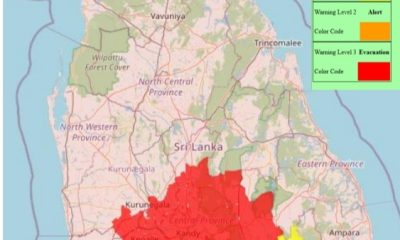
 Latest News7 days ago
Latest News7 days agoLevel III landslide early warnings issued to the districts of Badulla, Kandy, Kegalle, Kurunegala, Matale and Nuwara-Eliya
-

 Features7 days ago
Features7 days agoDitwah: An unusual cyclone
-
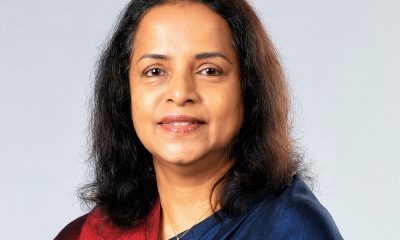
 Business3 days ago
Business3 days agoLOLC Finance Factoring powers business growth
-

 News3 days ago
News3 days agoCPC delegation meets JVP for talks on disaster response
-
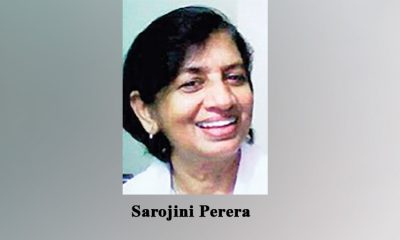
 News3 days ago
News3 days agoA 6th Year Accolade: The Eternal Opulence of My Fair Lady


